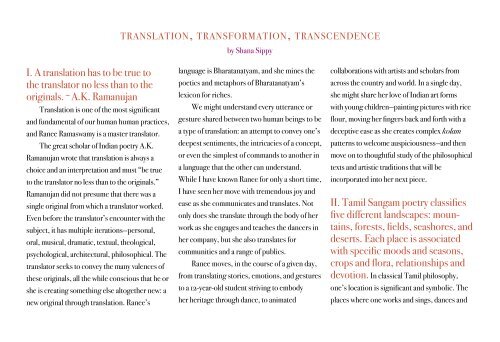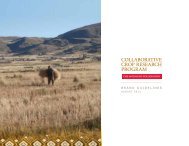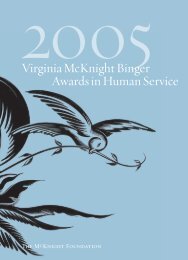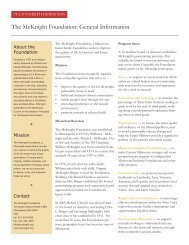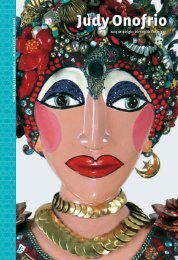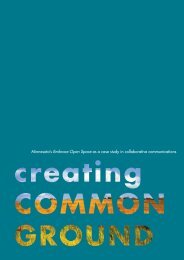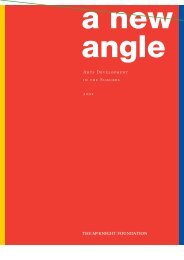PDF, 5 MB - McKnight Foundation
PDF, 5 MB - McKnight Foundation
PDF, 5 MB - McKnight Foundation
You also want an ePaper? Increase the reach of your titles
YUMPU automatically turns print PDFs into web optimized ePapers that Google loves.
translation, transformation, transcendence<br />
by Shana Sippy<br />
I. A translation has to be true to<br />
the translator no less than to the<br />
originals. ~ A.K. Ramanujan<br />
Translation is one of the most significant<br />
and fundamental of our human human practices,<br />
and Ranee Ramaswamy is a master translator.<br />
The great scholar of Indian poetry A.K.<br />
Ramanujan wrote that translation is always a<br />
choice and an interpretation and must “be true<br />
to the translator no less than to the originals.”<br />
Ramanujan did not presume that there was a<br />
single original from which a translator worked.<br />
Even before the translator’s encounter with the<br />
subject, it has multiple iterations—personal,<br />
oral, musical, dramatic, textual, theological,<br />
psychological, architectural, philosophical. The<br />
translator seeks to convey the many valences of<br />
these originals, all the while conscious that he or<br />
she is creating something else altogether new: a<br />
new original through translation. Ranee’s<br />
language is Bharatanatyam, and she mines the<br />
poetics and metaphors of Bharatanatyam’s<br />
lexicon for riches.<br />
We might understand every utterance or<br />
gesture shared between two human beings to be<br />
a type of translation: an attempt to convey one’s<br />
deepest sentiments, the intricacies of a concept,<br />
or even the simplest of commands to another in<br />
a language that the other can understand.<br />
While I have known Ranee for only a short time,<br />
I have seen her move with tremendous joy and<br />
ease as she communicates and translates. Not<br />
only does she translate through the body of her<br />
work as she engages and teaches the dancers in<br />
her company, but she also translates for<br />
communities and a range of publics.<br />
Ranee moves, in the course of a given day,<br />
from translating stories, emotions, and gestures<br />
to a 12-year-old student striving to embody<br />
her heritage through dance, to animated<br />
collaborations with artists and scholars from<br />
across the country and world. In a single day,<br />
she might share her love of Indian art forms<br />
with young children—painting pictures with rice<br />
flour, moving her fingers back and forth with a<br />
deceptive ease as she creates complex kolam<br />
patterns to welcome auspiciousness—and then<br />
move on to thoughtful study of the philosophical<br />
texts and artistic traditions that will be<br />
incorporated into her next piece.<br />
II. Tamil Sangam poetry classifies<br />
five different landscapes: mountains,<br />
forests, fields, seashores, and<br />
deserts. Each place is associated<br />
with specific moods and seasons,<br />
crops and flora, relationships and<br />
devotion. In classical Tamil philosophy,<br />
one’s location is significant and symbolic. The<br />
places where one works and sings, dances and


